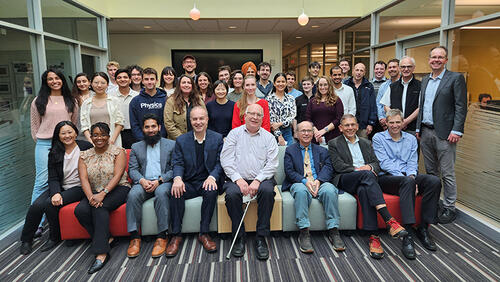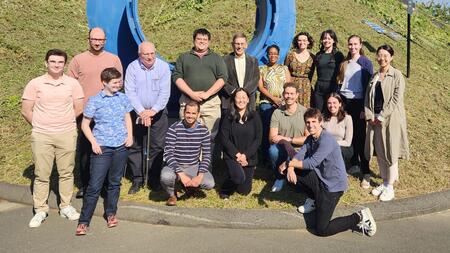
Wright Lab hosted two related experimental collaboration meetings the week of September 25, the Axion Longitudinal Plasma Haloscope (ALPHA) Collaboration from September 25-26 and the Haloscope At Yale Sensitive To Axion CDM (HAYSTAC) Collaboration from September 27-28.
Both ALPHA and HAYSTAC are designed to search for dark matter, which is one of the greatest mysteries in contemporary astrophysical research. By matching theory with observations, scientists believe that approximately 80% of the matter in the Universe is composed of dark matter, yet researchers have been unable to directly detect dark matter, and the nature of this substance is unknown.
The experiments are looking for a theorized particle called the axion, which is candidate for dark matter that, if detected, would provide important clues to the nature of dark matter and the constitution of the mass content of the universe.
HAYSTAC uses a tunable microwave cavity resonator along with quantum amplifiers to achieve sub-quantum limited noise in the search for high-mass axion dark matter. The experiment is located at Wright Lab, where the on-site team is responsible for designing, constructing and operating the experiment. The collaboration, which was founded in the early 2010s, also includes members from the University of California Berkeley, Johns Hopkins University, and the University of Colorado at Boulder.
ALPHA, which will also be located at Wright Lab, will build on the success of HAYSTAC and search for even higher mass axions by employing a novel axion detector called a plasma haloscope. The ALPHA collaboration was founded in May 2021. Yale recently joined the collaboration, which also includes researchers at Stockholm University, UC Berkeley, MIT, ITMO, the University of Arizona, Cambridge, the University of Maryland and UC Davis.
The ALPHA meeting at Wright Lab, attended by 48 people from 17 institutions, was the official “kickoff” meeting of the experiment, and included two days of talks by ALPHA researchers on current axion theory and experiments; results of ALPHA research and development efforts; techniques for the analysis of data; plans for administration, organization and funding of the experiment; and preliminary plans for upgrades. The attendees also toured Wright Lab, including the future site of ALPHA and the current site of HAYSTAC.
The HAYSTAC meeting followed the ALPHA meeting, and was attended by 17 people from 4 institutions.
Reina Maruyama, professor of physics and co-PI of HAYSTAC said, “We are very excited to host the ALPHA and HAYSTAC collaborations at Yale. ALPHA is a natural follow up to HAYSTAC and will allow us to sample a larger volume of the galaxy. I am also grateful to Professor Sean Barrett for the use of his magnet and Wright Lab and Yale for their support for the experiment.”
Mike Jewell, postdoctoral associate working with both experiments, said “HAYSTAC has been and will continue to be a pioneer for dark matter axion searches at high-mass. But extending HAYSTAC’s reach to higher masses, where some theorists predict the axion to be, is a challenging problem and requires innovative ideas. ALPHA provides exactly that by breaking the typical requirement that a high-mass search requires a small detection volume and opens up the door to previously un-explored axion parameter space.”
Jewell continued, “It’s exciting to get to work on such a project and we hope that the experience we bring from HAYSTAC will result in another successful axion experiment.”
Other members of Wright Lab who are currently involved in ALPHA and HAYSTAC are: Steve Lamoreaux, professor of physics and co-PI of HAYSTAC; Sid Cahn, senior research scientist; Max Silva-Feaver and Sabrina Zacarias, postdoctoral associates; Xiran Bai, Eleanor Graham, Claire Laffan, and Sukhman Singh, graduate students; and Elsa Durcan, undergraduate.

The HAYSTAC collaboration meeting in-person attendees.

